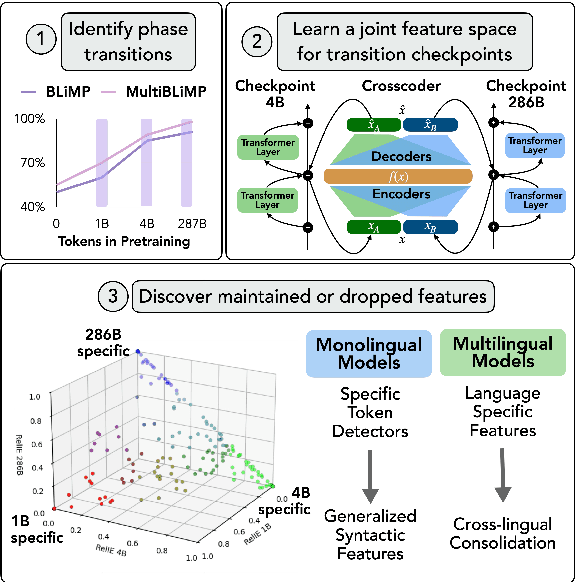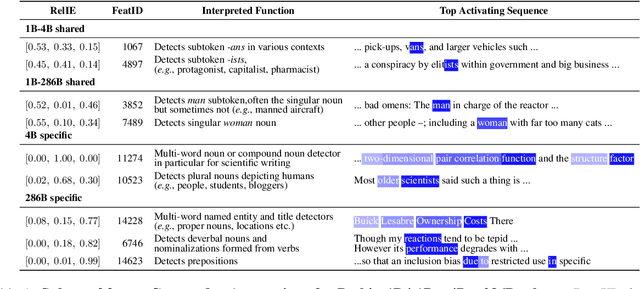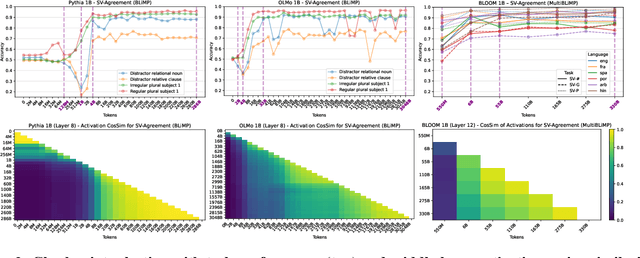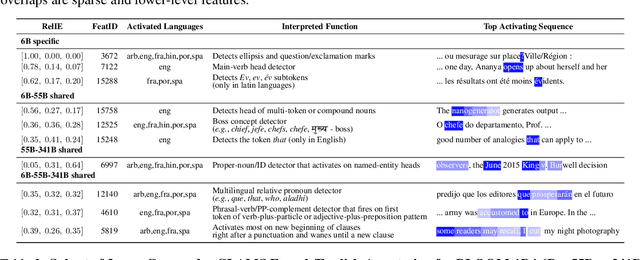Aaron Mueller
Crosscoding Through Time: Tracking Emergence & Consolidation Of Linguistic Representations Throughout LLM Pretraining
Sep 05, 2025



Abstract:Large language models (LLMs) learn non-trivial abstractions during pretraining, like detecting irregular plural noun subjects. However, it is not well understood when and how specific linguistic abilities emerge as traditional evaluation methods such as benchmarking fail to reveal how models acquire concepts and capabilities. To bridge this gap and better understand model training at the concept level, we use sparse crosscoders to discover and align features across model checkpoints. Using this approach, we track the evolution of linguistic features during pretraining. We train crosscoders between open-sourced checkpoint triplets with significant performance and representation shifts, and introduce a novel metric, Relative Indirect Effects (RelIE), to trace training stages at which individual features become causally important for task performance. We show that crosscoders can detect feature emergence, maintenance, and discontinuation during pretraining. Our approach is architecture-agnostic and scalable, offering a promising path toward more interpretable and fine-grained analysis of representation learning throughout pretraining.
SAEs Are Good for Steering -- If You Select the Right Features
May 26, 2025Abstract:Sparse Autoencoders (SAEs) have been proposed as an unsupervised approach to learn a decomposition of a model's latent space. This enables useful applications such as steering - influencing the output of a model towards a desired concept - without requiring labeled data. Current methods identify SAE features to steer by analyzing the input tokens that activate them. However, recent work has highlighted that activations alone do not fully describe the effect of a feature on the model's output. In this work, we draw a distinction between two types of features: input features, which mainly capture patterns in the model's input, and output features, which have a human-understandable effect on the model's output. We propose input and output scores to characterize and locate these types of features, and show that high values for both scores rarely co-occur in the same features. These findings have practical implications: after filtering out features with low output scores, we obtain 2-3x improvements when steering with SAEs, making them competitive with supervised methods.
How to Improve the Robustness of Closed-Source Models on NLI
May 26, 2025Abstract:Closed-source Large Language Models (LLMs) have become increasingly popular, with impressive performance across a wide range of natural language tasks. These models can be fine-tuned to further improve performance, but this often results in the models learning from dataset-specific heuristics that reduce their robustness on out-of-distribution (OOD) data. Existing methods to improve robustness either perform poorly, or are non-applicable to closed-source models because they assume access to model internals, or the ability to change the model's training procedure. In this work, we investigate strategies to improve the robustness of closed-source LLMs through data-centric methods that do not require access to model internals. We find that the optimal strategy depends on the complexity of the OOD data. For highly complex OOD datasets, upsampling more challenging training examples can improve robustness by up to 1.5%. For less complex OOD datasets, replacing a portion of the training set with LLM-generated examples can improve robustness by 3.7%. More broadly, we find that large-scale closed-source autoregressive LLMs are substantially more robust than commonly used encoder models, and are a more appropriate choice of baseline going forward.
MIB: A Mechanistic Interpretability Benchmark
Apr 17, 2025Abstract:How can we know whether new mechanistic interpretability methods achieve real improvements? In pursuit of meaningful and lasting evaluation standards, we propose MIB, a benchmark with two tracks spanning four tasks and five models. MIB favors methods that precisely and concisely recover relevant causal pathways or specific causal variables in neural language models. The circuit localization track compares methods that locate the model components - and connections between them - most important for performing a task (e.g., attribution patching or information flow routes). The causal variable localization track compares methods that featurize a hidden vector, e.g., sparse autoencoders (SAEs) or distributed alignment search (DAS), and locate model features for a causal variable relevant to the task. Using MIB, we find that attribution and mask optimization methods perform best on circuit localization. For causal variable localization, we find that the supervised DAS method performs best, while SAE features are not better than neurons, i.e., standard dimensions of hidden vectors. These findings illustrate that MIB enables meaningful comparisons of methods, and increases our confidence that there has been real progress in the field.
Findings of the BabyLM Challenge: Sample-Efficient Pretraining on Developmentally Plausible Corpora
Apr 10, 2025



Abstract:Children can acquire language from less than 100 million words of input. Large language models are far less data-efficient: they typically require 3 or 4 orders of magnitude more data and still do not perform as well as humans on many evaluations. These intensive resource demands limit the ability of researchers to train new models and use existing models as developmentally plausible cognitive models. The BabyLM Challenge is a communal effort in which participants compete to optimize language model training on a fixed data budget. Submissions are compared on various evaluation tasks targeting grammatical ability, downstream task performance, and generalization. Participants can submit to up to three tracks with progressively looser data restrictions. From over 30 submissions, we extract concrete recommendations on how best to train data-efficient language models, and on where future efforts should (and perhaps should not) focus. The winning submissions using the LTG-BERT architecture (Samuel et al., 2023) outperformed models trained on trillions of words. Other submissions achieved strong results through training on shorter input sequences or training a student model on a pretrained teacher. Curriculum learning attempts, which accounted for a large number of submissions, were largely unsuccessful, though some showed modest improvements.
* Published in Proceedings of BabyLM. Please cite the published version on ACL anthology: http://aclanthology.org/2023.conll-babylm.1/
Position-aware Automatic Circuit Discovery
Feb 07, 2025Abstract:A widely used strategy to discover and understand language model mechanisms is circuit analysis. A circuit is a minimal subgraph of a model's computation graph that executes a specific task. We identify a gap in existing circuit discovery methods: they assume circuits are position-invariant, treating model components as equally relevant across input positions. This limits their ability to capture cross-positional interactions or mechanisms that vary across positions. To address this gap, we propose two improvements to incorporate positionality into circuits, even on tasks containing variable-length examples. First, we extend edge attribution patching, a gradient-based method for circuit discovery, to differentiate between token positions. Second, we introduce the concept of a dataset schema, which defines token spans with similar semantics across examples, enabling position-aware circuit discovery in datasets with variable length examples. We additionally develop an automated pipeline for schema generation and application using large language models. Our approach enables fully automated discovery of position-sensitive circuits, yielding better trade-offs between circuit size and faithfulness compared to prior work.
Disjoint Processing Mechanisms of Hierarchical and Linear Grammars in Large Language Models
Jan 15, 2025



Abstract:All natural languages are structured hierarchically. In humans, this structural restriction is neurologically coded: when two grammars are presented with identical vocabularies, brain areas responsible for language processing are only sensitive to hierarchical grammars. Using large language models (LLMs), we investigate whether such functionally distinct hierarchical processing regions can arise solely from exposure to large-scale language distributions. We generate inputs using English, Italian, Japanese, or nonce words, varying the underlying grammars to conform to either hierarchical or linear/positional rules. Using these grammars, we first observe that language models show distinct behaviors on hierarchical versus linearly structured inputs. Then, we find that the components responsible for processing hierarchical grammars are distinct from those that process linear grammars; we causally verify this in ablation experiments. Finally, we observe that hierarchy-selective components are also active on nonce grammars; this suggests that hierarchy sensitivity is not tied to meaning, nor in-distribution inputs.
Large Language Models Share Representations of Latent Grammatical Concepts Across Typologically Diverse Languages
Jan 10, 2025Abstract:Human bilinguals often use similar brain regions to process multiple languages, depending on when they learned their second language and their proficiency. In large language models (LLMs), how are multiple languages learned and encoded? In this work, we explore the extent to which LLMs share representations of morphosyntactic concepts such as grammatical number, gender, and tense across languages. We train sparse autoencoders on Llama-3-8B and Aya-23-8B, and demonstrate that abstract grammatical concepts are often encoded in feature directions shared across many languages. We use causal interventions to verify the multilingual nature of these representations; specifically, we show that ablating only multilingual features decreases classifier performance to near-chance across languages. We then use these features to precisely modify model behavior in a machine translation task; this demonstrates both the generality and selectivity of these feature's roles in the network. Our findings suggest that even models trained predominantly on English data can develop robust, cross-lingual abstractions of morphosyntactic concepts.
Incremental Sentence Processing Mechanisms in Autoregressive Transformer Language Models
Dec 06, 2024Abstract:Autoregressive transformer language models (LMs) possess strong syntactic abilities, often successfully handling phenomena from agreement to NPI licensing. However, the features they use to incrementally process language inputs are not well understood. In this paper, we fill this gap by studying the mechanisms underlying garden path sentence processing in LMs. We ask: (1) Do LMs use syntactic features or shallow heuristics to perform incremental sentence processing? (2) Do LMs represent only one potential interpretation, or multiple? and (3) Do LMs reanalyze or repair their initial incorrect representations? To address these questions, we use sparse autoencoders to identify interpretable features that determine which continuation - and thus which reading - of a garden path sentence the LM prefers. We find that while many important features relate to syntactic structure, some reflect syntactically irrelevant heuristics. Moreover, while most active features correspond to one reading of the sentence, some features correspond to the other, suggesting that LMs assign weight to both possibilities simultaneously. Finally, LMs do not re-use features from garden path sentence processing to answer follow-up questions.
Findings of the Second BabyLM Challenge: Sample-Efficient Pretraining on Developmentally Plausible Corpora
Dec 06, 2024Abstract:The BabyLM Challenge is a community effort to close the data-efficiency gap between human and computational language learners. Participants compete to optimize language model training on a fixed language data budget of 100 million words or less. This year, we released improved text corpora, as well as a vision-and-language corpus to facilitate research into cognitively plausible vision language models. Submissions were compared on evaluation tasks targeting grammatical ability, (visual) question answering, pragmatic abilities, and grounding, among other abilities. Participants could submit to a 10M-word text-only track, a 100M-word text-only track, and/or a 100M-word and image multimodal track. From 31 submissions employing diverse methods, a hybrid causal-masked language model architecture outperformed other approaches. No submissions outperformed the baselines in the multimodal track. In follow-up analyses, we found a strong relationship between training FLOPs and average performance across tasks, and that the best-performing submissions proposed changes to the training data, training objective, and model architecture. This year's BabyLM Challenge shows that there is still significant room for innovation in this setting, in particular for image-text modeling, but community-driven research can yield actionable insights about effective strategies for small-scale language modeling.
 Add to Chrome
Add to Chrome Add to Firefox
Add to Firefox Add to Edge
Add to Edge